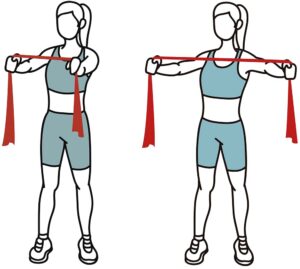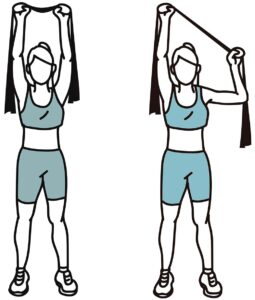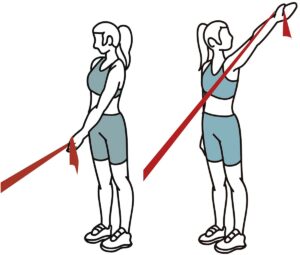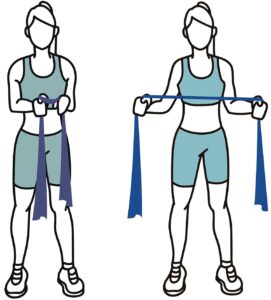12 Physiotherapy Exercises for Shoulder Pain Relief at Home

In this post we want to show you how to do physiotherapy exercises for shoulder pain using resistance bands and/or an exercise pulley.
Shoulder pain is extremely common and can be difficult to treat using medication. Although more severe cases may require surgery, often the root cause of your shoulder pain can be effectively treated with physiotherapeutic exercises. These exercises are designed to strengthen your rotator cuff and surrounding muscles and stretch your shoulder joint to improve range of motion.
The shoulder pain exercises in this guide are safe and effective for the relief of shoulder discomfort and stiffness. However, for more serious shoulder conditions, it’s essential that you seek the advice of a physiotherapy specialist before starting rehab exercises.
How to do Physiotherapy Exercises for Shoulder Pain
Resistance Bands
For strengthening your rotator cuff muscles, the best physiotherapy tool you can use is a resistance band:
Physiotherapy bands are especially effective for shoulder pain exercises because, unlike weights, they can be used to apply gentle resistance to any movement, from any angle. This is particularly useful for doing rotational shoulder exercises, which are the most effective for relief of shoulder pain.
Shoulder Pulley
Another option for shoulder physio, especially if you have limited range of motion, is a shoulder exercise pulley:
This guide includes 4 shoulder pulley exercises for pain relief, but for a more in-depth guide to the pulley, please see this post.
8 Physio Band Exercises for Shoulder Pain
You can do these resistance band exercises in any order, but try to do at least one set of each and do them on a regular basis. Rotational exercises 1, 2 and 8 are the most effective for strengthening of your rotator cuff muscle, which is especially important for good shoulder health.
1. Internal Shoulder Rotator

Anchor the band to a fixed point, for example a door handle. Keeping your elbow close to your side (you can put a rolled towel between your body and upper arm to limit arm movement), stretch the band by rotating your shoulder inwards. Be sure to keep your posture upright and shoulder in a neutral position.
2. External Shoulder Rotator

Same as the first exercise, except this time you rotate your shoulder outwards. Be sure to keep your shoulder back (not hunched forward) and your elbow in to your side. Putting a towel between your body and upper arm may help with this.
3. Horizontal Arm Extension

Hold the band horizontally with arms at shoulder level in front of you. Keep your elbows slightly unlocked and your posture upright. Pull the band apart as far as possible and hold briefly, squeezing your shoulder blades together.
4. Rear Arm Extension

Hold the band behind your back with arms straight (elbows unlocked). Pull the band apart, keeping an upright posture. Hold briefly in final position.
5. Lat Pulldown

Hold the band over your head at arms length, keeping one arm straight and firmly braced. Pull the band downwards and outwards to head height using your other arm.
6. Diagonal Shoulder Flexion

Secure the band below waist level and hold onto one end with your arm straight and your hand at the opposite hip. Pull the band upward and away from your body without bending your arm. Keep your posture upright throughout the exercise.
7. Vertical Arm Extension

Hold the band with straight arms extended in front of you. One arm should be higher than the other. Pull the band apart, moving the arms in a vertical plane.
8. Outward Shoulder Rotation

Hold the band with your forearms extended in front of you and elbows held in to your sides. Stretch the band apart by rotating your shoulders outward. Keep your forearms horizontal. Your shoulders should stay in a natural position, not hunched up or forward.
4 Shoulder Pulley Exercises for Pain & Stiffness
The shoulder pulley can be used for passive resistance exercises and for gently stretching and strengthening the shoulder joint. For best results, you can use the pulley in conjunction with resistance bands. But if in doubt, always consult a physiotherapist to find out the best way to treat your shoulder pain.
See our full shoulder pulley guide for more information about using this physiotherapy tool.
1. Front Stretch

Fix the pulley at the top of the door frame and sit in a chair facing away from the door. Hold the handles with arms straight in front of you. Stretch one arm up as far as you can and then switch arms. Use passive resistance during the movement to exercise your shoulder. Do this as a continuous movement for as long as you feel comfortable.
2. Side Stretch

Same as the previous exercise except this time your arms are out to the side of your body, not in front.
3. Backward Stretch

Stand side-on to the door. Using the pulley, lift one arm behind your back, as in the picture. Stretch the shoulder as far as comfortable, and apply some passive resistance in the movement.
4. Shoulder Rotation

Standing side-on to the door, pull arm so that it is rotating outwards. Don’t let your shoulder hunch up or slump forward. Maintain a natural upright posture, and keep your elbow fixed at your side. Holding a rolled up towel between your elbow and body can help with this.
We hope these physiotherapy shoulder pain exercises will be useful for you. Feel free to contact us if you have any questions.



